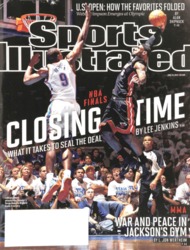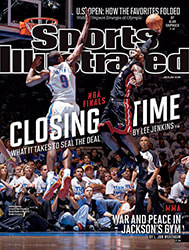
That's So Euro
Roger Goodell knows it; the 2012 tournament in Poland and Ukraine shows it: There's something about f√∫tbol that football lacks
Few scenes in sports can match the emotional power of the one that Irish soccer fans produced at their Euro 2012 game against Spain in Gda¬¥nsk, Poland, last week. In the final minutes of a 4--0 loss to the defending champions, the Irish supporters, a majority in the stadium, could have booed and whistled at their own team or quietly filed out into the Polish night. Instead the 25,000-strong Green Army sang a hauntingly beautiful rendition of The Fields of Athenry, an Irish folk ballad that had witnesses agreeing afterward: There are no fans in the world more passionate, supportive and just plain fun than the Irish. Defender Gerard Piqué said he'll remember Fields of Athenry as long as he lives—and he plays for Spain.
Even mainstream U.S. sports fans are noticing the fervent followings at Euro 2012. Through eight games, ESPN, which is broadcasting every match live, was averaging 1.26 million English-language viewers, up 183% from Euro 2008. No less an authority than NFL commissioner Roger Goodell marveled at European soccer, telling SI's Peter King that he would love to replicate the spontaneous songs and chants that are as much a hallmark of the stadium experience as blaring music, Kiss Cams and T-shirt cannons are part of the NFL and other artificially enhanced U.S. sports.
But is that even possible? And would American fans want it? Just what is it about soccer that provokes such extreme and heartfelt fan behavior? If you'd spent a week driving around Poland and Ukraine at Euro 2012, you would have encountered the full spectrum of soccer fandom. In Warsaw before the Poland-Russia game, some 5,000 Russian hardcores marched through the streets to celebrate a national holiday, only to clash with Polish ultras in an ugly scene that resulted in almost 200 arrests. And there were isolated incidents of racial abuse—black players from the Czech, Dutch and Italian teams were subjected to monkey chants from pockets of opposing fans in Poland, something all but unthinkable in an American stadium but disturbingly common in certain areas of Europe.
But in Gdańsk, Irish fans took over a town square and danced with their Spanish counterparts in what Green Army types happily called "a flamenco jig." In Wroclaw on Saturday, Polish fans unfurled a giant national flag and chanted "Pol-ska!" to the tune of the Village People's Go West throughout a match in which the co-hosts were eliminated by the Czech Republic.
On Friday, I talked to Kuba Krzyžostaniak, a 24-year-old Polish-American who immigrated to Madison, Wis., at age five, has returned to live in Poznań and considers himself a passionate supporter of the Green Bay Packers, Wisconsin Badgers football and the Polish soccer club Lech Poznań. "Nothing in America compares to a game here," says Krzyžostaniak, who goes by @KubaLech on Twitter. "The 43,000 people at a Lech Poznań game are louder than the 80,000 at a Wisconsin football game. The singing and chanting are part of the tradition and history here. You grow up with it, and you get used to it."
Lech Poznań supporters are regarded as a festive crowd even for soccer fans, the Cameron Crazies of Europe. (Might Duke coach Mike Krzyzewski tell you it's a Polish thing?) A few years ago the Lech faithful popularized a celebration in which they turn their backs to the field, join arms and jump up and down in unison. When they performed the rite at a 2010 Europa League game at Manchester City, Krzyžostaniak recalls, the English fans responded with their own chant: What the f------ hell is that? Later, though, Man City adopted the Poznań, and since then the celebration has gone viral in soccer stadiums spanning Europe, and has even reached Red Bull Arena in Harrison, N.J.
Like Goodell, Krzyžostaniak has wondered if the NFL might be able to encourage the in-stadium experience to be more organic and crowd-driven by introducing a section of the stadium reserved for hardcore fans with less expensive tickets, cheap beer and even a chant organizer on a platform who faces the crowd and acts as a sort of sporting Arthur Fiedler. (Hardcore sections are common in soccer, including in MLS stadiums, and "conductors" have been used in college sports for years.) Krzyžostaniak has his doubts, though, speculating that U.S. fan traditions and the socioeconomic status of modern-day NFL crowds (read: middle- and upper-middle-class) may prevent the Poznań from taking over, say, Pittsburgh. "Maybe middle-class people don't like singing at games as much?" he hypothesizes. That's possible, but there are plenty of boisterous, European-style sections for middle-class MLS fans in Portland, Seattle, Kansas City and elsewhere that suggest otherwise.
Yet there is one crowd phenomenon that has traveled in the other direction, from North American sports to European soccer, and it appeared more than once at Euro 2012 last week: the Wave. Europeans call it "the Mexican wave" since most of them saw it for the first time at the 1986 World Cup in Mexico, even though its origins can be traced before that to the U.S. and Canada. Then again, the Wave is one supporter craze that U.S. fans might be happy is erroneously attributed to someone else. Just as you won't find Beyoncé dancing the Macarena or the Cameron Crazies leading a "Bulls---" chant, the trendsetters in Pozna≈Ñ wouldn't be caught dead doing the Wave. It may be time for the NFL commissioner to go on a cool-hunting trip to Poland.
SIGN OF THE APOCALYPSE
James Hearns, a senior linebacker from Tallahassee's Lincoln High who has committed to Florida, was ejected from a football camp at Florida State for performing the Gator Chomp.
ILLUSTRATION
ILLUSTRATION BY DARROW
PHOTO
DERICK E. HINGLE/US PRESSWIRE (GATOR)

